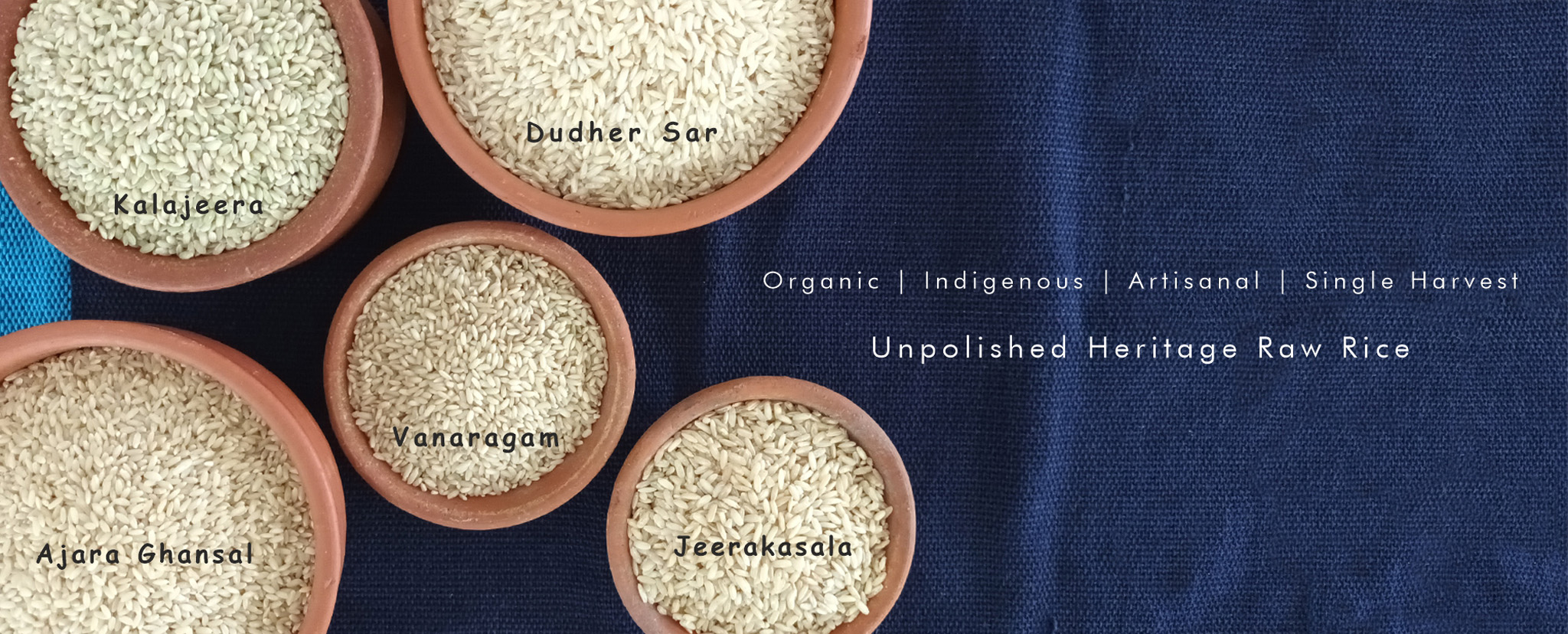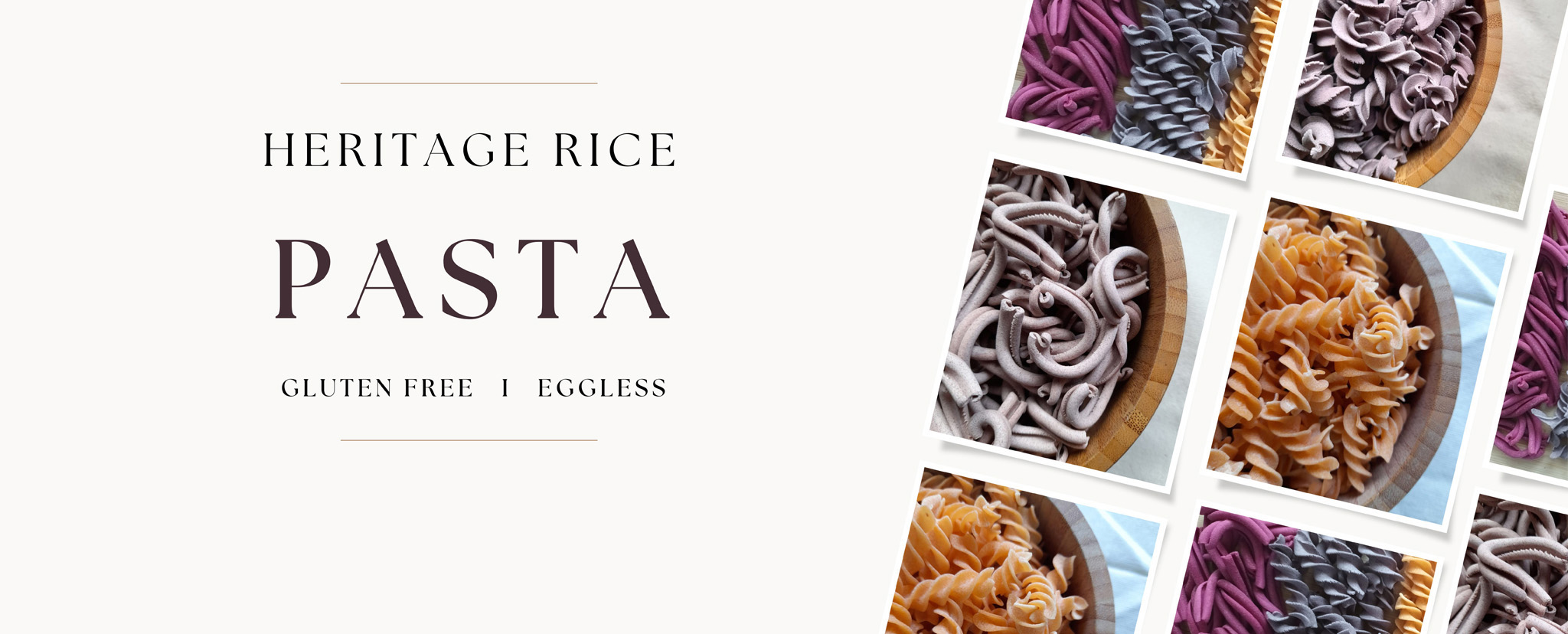Soak the Acharmati Raw polished rice for 1/2 hour before cooking. Cook it in the ratio of 1:2.5 (For 1 cup rice, add 2.5 cups water). Please adjust the water ratio according to your preference.
Welcome to Spirit of the Earth.
From the farm to the kitchen and finally to your dining table, we are germinating a whole new revolution of bringing back traditional rice varieties of India.
And we Thank YOU for being a part of this journey.


EXPLORE OUR RICE VARIETIES
-
Acharmati
₹140.00 Per KgOdisha
Acharmati is a short bold rice from Odisha. Though it has pleasant yellow husk, when removed, the kernel is dull white in colour. This fragrant grain is an autumn crop and accordingly to farmers is a high yielding variety. Most scented rice variants from this region are used to make kichadi, pulao, kheer or served as plain table rice.
Cooking Instructions
-
Acharmati Arisi Upma Mix
₹433.33 Per KgIngredients: Acharmati Rice, Chilli Flakes, Toor Dal, Pepper, Salt, Gram Dal, Urad Dal, Mustard, Jeera
Cooking Instructions: Heat sesame oil or coconut oil in a pan. Add mustard seeds and allow it to crackle. Add the split urad dal, curry leaves, hing, broken red chillies and onions (optional). Add 3 cups of water and let boil. Add 1 measure of Acharmati Upma blend, and let it cook in an open pan for 20 minutes. Once water is absorbed, remove from heat and close the pan. Let it rest for 10 minutes before serving.
-
Acharmati Rice Flour
₹160.00 Per KgOdisha
It can be used to make a variety of delicious recipes like Kozhukattai, Murukku, Idiyappam, Dosai, Akki Roti etc. It acts as a thickener in sauces, soups, stews, gravies, curries etc.
-
Adam Chini
₹140.00 Per KgUttar Pradesh
Cooking Instructions
Soak the Adam Chini Raw rice for 2-3 hours before cooking. Cook it in the ratio of 1:4 (For 1 cup rice, add 4 cups water). Please adjust the water ratio according to your preference.
Soak the Adam Chini Raw polished rice for 10 mts before cooking. Cook it in the ratio of 1:2.5 (For 1 cup rice, add 2.5 cups water). Please adjust the water ratio according to your preference.
-
Ajara Ghansal
₹140.00 Per KgMaharashtra
Ajara Ghansal grown in Kolhapur district is an aromatic grain, which has been cultivated over many generations in Ajara Taluk – some families of farmers have been cultivating Ghansal rice for more than 100 years. Known for its taste and aroma, Ghansal rice is tender and non-sticky.
Cooking Instructions
Soak the Ajara Ghansal raw rice for 2-3 hours before cooking. Cook it in the ratio of 1:4 (For 1 cup rice, add 4 cups water). Please adjust the water ratio according to your preference.
Soak the Ajara Ghansal Raw polished rice for 10 mts before cooking. Cook it in the ratio of 1:2.5 (For 1 cup rice, add 2.5 cups water). Please adjust the water ratio according to your preference.
-
Ambe Mohar
₹140.00 Per KgMaharashtra
“Pej/ Kanji (rice gruel) makes for a great health drink because it allows for better assimilation of Vit D & calcium,” explains nutritionist and fitness expert Rujuta Diwekar. And Ambemohar was the rice used by people in Maharashtra (particularly the Mulshi region in Pune) to prepare this nutritious dish, and it was relished by children and adults.
This short and low yielding grain has the aroma of mango blossoms, hence the name( Ambe means mango, mohar means flowers). It was extensively used in Maharashtra for religious ceremonies and during festivals; the rice was also used to make puffed rice called murmure; the bran from this grain has been used for oil extraction and mushroom cultivation. However since the yield was low, a hybrid variant called Indrayani with ambemohar parentage was developed by the Rice Research Centre near Lonavala. Due to this, farmers gave up this traditional grain in the late 1980s. Awarded a GI tag in 2016, Mulshi Ambemohar rice is believed to have been a favourite of the Peshwa rulers.
Cooking Instructions
Soak the Ambe Mohar raw rice for 2-3 hours before cooking. Cook it in the ratio of 1:4 (For 1 cup rice, add 4 cups water). Please adjust the water ratio according to your preference.
Soak the Ambe Mohar polished rice for 10 minutes before cooking. Cook it in the ratio of 1:2.5 (For 1 cup rice, add 2.5 cups water). Please adjust the water ratio according to your preference.
-
Arcot Kichili Champa Adai Batter
Per Kg₹180.00
Currently servicing Chennai city.
Available for store pick up every Tuesday & Friday.
Contact 87544 76702 to order.Ingredients: Arcot Kichili Champa Rice, Black Urad Dal, Tuvar Dal, Chana Dal, Moringa Leaves, Jeera Seeds, Ginger, Red Chilli, Asafoetida, Turmeric, Salt and RO Water.
-
Anandanoor Sanna
₹130.00 Per KgTamilnadu
This traditional variety is named after the region it was cultivated, namely Anandanoor. After interactions with local farmers, we believe this could be around modern day Salem district. Sanna indicates the fine, delicate feature of this grain as Sanna refers to fine and thin in Tamil. This is a slender white grain and cooks very well making Anandanoor Sanna a preferred choice for tamarind rice, sambar rice and every day rice preparations. Ananda also means joy, which holds true in the case of this rice because of its light texture and easy to digest properties!
Cooking Instructions
ags: Brown Rice, Everyday Table Rice, Iddly, Dosa, CholestrolSoak the Anandanoor Sanna Raw polished rice for 10 mts before cooking. Cook it in the ratio of 1:2.5 (For 1 cup rice, add 2.5 cups water). Please adjust the water ratio according to your preference.


Possibly one of the first in India, Spirit of the Earth’s Heritage Rice of India subscription boxes are an experience – one that allows customers to appreciate and rediscover the indigenous grains of India.













